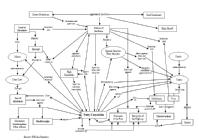My PhD considered the work of Hertfordshire’s petty constables from 1730 to 1799. Research found that two-thirds of (58) parishes appointed their constables, and other regulatory officers, in manorial courts leet throughout the eighteenth century. Many continued doing so until the eve of constabulary reforms in 1841. Hertfordshire’s eighteenth century leets also heard a handful of nuisance or weights and measures offences annually, but records of thefts, assaults and other minor offences were not found in the studied manorial records.
From 1733 to 1782 Cheshunt’s leet met annually at Whitsuntide to appoint officers and prosecute half a dozen nuisance and trading offences. George Prescott, self-made financier and magistrate, bought the manor in late 1782 and began convening courts at both Whitsuntide and Michaelmas. He had previously been extremely active in vestries, on committees and on the bench, and used his new leet’s powers to address several local issues. His first leet ordered an unprecedented twenty-nine landowners to make bridge, road and ditch repairs. The six aleconners appointed in Prescott’s second leet in May 1783 (to oversee the quality of beer and check it was sold in the correct measures) were all ‘esquires’, where officers were usually local tradesmen, farmers and craftsmen. They reported thirty-one traders for weights and measures offences to the next leet. These high levels of leet prosecutions continued throughout the 1780s but returned to pre-Prescott levels shortly after his death in 1790. Prescott therefore clearly used his personal authority as lord of the manor to augment his official powers as a magistrate, including co-opting unusually high-status individuals to assist him.
My current research therefore examines, inter alia, the intersection of official and personal authority, the officers and authority structures within parishes and the continued importance of manorial courts in asserting local authority.
Elaine Saunders (@earlypolicing)

